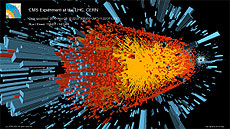LHC basics: What we can learn from lead-ion collisions
 |
|
A lead-ion collision as recorded by the CMS detector at the LHC. Credit: CERN |
The LHC has been smashing lead ions since Sunday, and physicists from the ALICE, ATLAS and CMS experiments are working around the clock to analyze the aftermath of these heavy-ion collisions at record energies and temperatures.* Last week we walked you through the process of creating, accelerating and colliding lead ions. Now we’ll talk about the big question: Why spend one month each year colliding heavy ions in the LHC?
The building blocks and mini "big bangs"
To understand why physicists around the world study heavy-ion collisions, we need to review some basic particle physics and discuss what happens when two nuclei collide at ultra-high energies.
First, the basics. Everything you see around you is composed of atoms, which are themselves composed of protons and neutrons bound together in an atomic nucleus, surrounded by a cloud of electrons. Electrons are one of the basic building blocks of matter, but protons and neutrons are not—they are in turn composed of elementary particles called quarks.
The strong force binds quarks inside composite particles, such as protons, via other elementary particles called gluons. Thus lead nuclei, which are made up of protons and neutrons, are really composed of many quarks and gluons.
When two lead nuclei slam into each other at high enough energies, they form a fireball of hot, dense matter. The temperatures created in the fireball are so great that they ‘melt’ the protons and neutrons. The result is a state of matter called the quark gluon plasma, in which quarks and gluons roam freely. The QGP exists for only an instant before the fireball expands and cools to the point where quarks and gluons once again form composite particles.
Read more
|